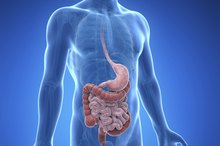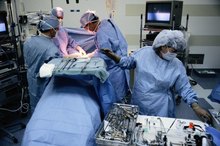Symptoms Following Ileostomy Reversal
If all or part of the large intestine requires removal due to disease or cancer, the end of the small intestine -- the ileum -- temporarily connects to the outside of the body through a small hole in the abdominal wall. Stool collects in special bags over this opening. These ileostomies allow the bowel to rest and heal after surgery, explains the Crohn's and Colitis Foundation of America 2. After a period of several months, surgeons reverse the ileostomy, hooking the small intestine back up to the remnant of the colon, the rectum or the anus.
If you are experiencing serious medical symptoms, seek emergency treatment immediately.
Frequent Bowel Movements
Reconnecting the small intestine to the rectum restores the ability to have bowel movements without an ileostomy bag. Before excision, the colon collected and stored stool until passing it from the body. The small intestine, although altered by surgeons for this purpose, adapts, but never fully attains the ability to do this quite as well. In the first few days after surgery, watery and urgent bowel movements may number in the 30s or higher. After a few weeks, this number declines to about half of this value. Over the next few months to about a year, the number and urgency of bathroom visits continues to drop. Most people eventually have between 4 and 8 comfortable bowel movements per day after the small intestine "learns" to hold and control stool output.
- Reconnecting the small intestine to the rectum restores the ability to have bowel movements without an ileostomy bag.
- In the first few days after surgery, watery and urgent bowel movements may number in the 30s or higher.
Incontinence
Complications of Colostomy Reversal
Learn More
An article in the May 2008 issue of "The World Journal of Gastroenterology" explains that about 60 percent of people experience some leakage of stool, called incontinence 3. Fortunately, incontinence occurs only occasionally in the first 2 to 3 months after surgery and usually during sleep. Steady improvement over time leaves about 3 percent of people with ongoing incontinence issues over a year after the ileostomy reversal. Rarely, incontinence becomes severe and a permanent ileostomy is placed.
- An article in the May 2008 issue of "The World Journal of Gastroenterology" explains that about 60 percent of people experience some leakage of stool, called incontinence 3.
- Fortunately, incontinence occurs only occasionally in the first 2 to 3 months after surgery and usually during sleep.
Obstruction
The "International Journal of Colorectal Disease" reviewed 48 original studies on the subject and found the overall rate of small bowel obstruction following ileostomy and its reversal exceeded 7 percent 1. Abdominal surgeries leave scar tissue inside the abdomen, which then binds to the intestine causing it to narrow, leading to obstructions. Unlike frequent bowel movements and incontinence, which are expected, obstruction constitutes a complication. Heralded by waves of abdominal pain, bloating, nausea and vomiting, obstruction can become quite serious. Partial obstructions usually pass by themselves, but complete obstructions, where no stool or gas passes, sometimes require emergency surgery.
- The "International Journal of Colorectal Disease" reviewed 48 original studies on the subject and found the overall rate of small bowel obstruction following ileostomy and its reversal exceeded 7 percent 1.
- Abdominal surgeries leave scar tissue inside the abdomen, which then binds to the intestine causing it to narrow, leading to obstructions.
Infection
Long-Term Effects of a Colectomy
Learn More
Five percent of patients develop leakage of stool inside the abdomen. Leaking occurs at the site where the small intestine is reconnected by sutures or staples to the rectum or anus. Fever and lower abdominal or pelvic pain signal a potential leak with infection. Because the infection may enter the bloodstream, these symptoms require prompt medical testing and treatment.
- Five percent of patients develop leakage of stool inside the abdomen.
- Fever and lower abdominal or pelvic pain signal a potential leak with infection.
Related Articles
References
- "International Journal of Colorectal Disease"; The Morbidity Surrounding Reversal of Defunctioning Ileostomies: A Systematic Review of 48 Studies Including 6,107 cases; A. Chow, H.S. Tinley, et al; June 1, 2009
- "World Journal of Gastroenterology"; John M. Hwang and Madhulika G. Varma; May 2008
- American Cancer Society. "Ileostomy." Cancer.org 17 Mar 2011.
- NHS Choices. "Ileostomy." National Health Service 3 Sept 2012.
- United Ostomy Associations of America, Inc. "Ileostomy Guide." Ostomy.org 2011.
Writer Bio
Cheryl Orr is a board-certified anesthesiologist who began writing professionally in 2010. She has been published in "Anesthesiology" and the "Journal of Clinical Anesthesia." She authored "General Anesthesia for Trauma" in the reference text "TRAUMA: Emergency Resuscitation, Perioperative Anesthesia, Surgical Management," published in 2007. Orr earned her medical degree from the University of Pittsburgh.








